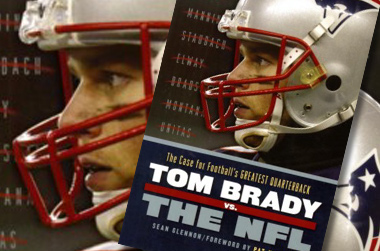The first time New England Patriots owner Robert Kraft met Tom Brady, the young quarterback was walking down the stairs of the old Foxboro Stadium, with a pizza box stuffed under his arm. Kraft interrupted the skinny rookie before he could introduce himself. “I know who you are,” he said. “You’re Tom Brady. You’re our sixth-round draft choice.” To which Brady responded by looking his boss right in the eyes, and saying, “I’m the best decision this organization ever made.”
At least, that’s how Robert Kraft tells the tale 12 years, five Super Bowl appearances and three championships later.
“The location of that story tends to change a bit,” local author Sean Glennon tells me, as we discuss his new book Tom Brady vs. the NFL: The Case for Football’s Greatest Quarterback. “Sometimes it’s in the parking lot, sometimes on the steps of the stadium, or just after practice.”
A native Bay Stater and lifelong football fan, Glennon (a former Valley Advocate music columnist) has written several books about the Patriots, including Game Changers: The New England Patriots, The Good, the Bad and the Ugly: New England Patriots, and This Pats Year: A Trek Through a Season as a Football Fan. But his latest foray into football history, he says, proved the most difficult yet.
Tom Brady vs. the NFL is something of a monumental undertaking, as would be any sports book attempting to prove that a certain player is the best of all time. Nevertheless, that is exactly what Glennon sets out to do, using a significant number of stats, as well as his conversational story style, to tell the tale of Tom Brady and compare the face of the New England franchise to the best quarterbacks in football history: Manning, Marino, Montana, Starr, Unitas, and a dozen more.
“Football history is horribly under-appreciated,” states Glennon, himself a member of the Professional Football Researchers Association, adding that while he was careful to balance the numbers with the story of Brady’s rise to historically elite status, he enjoyed indulging in the geeky stats as well.
Which is good news for football fans looking to appreciate Brady’s place in the annals of football history, and certainly in the game today. And it is likewise a refreshing change of perspective on an athlete whose off-the-field endeavors have gotten more and more press, despite the continuation of his stellar on-the-field career.
“It’s not a book about Tom Brady the celebrity,” Glennon writes in the introduction. “It’s not a book about Brady’s wife, his kids, or his former girlfriends. It’s not about Brady’s wedding or his car accident. And it’s certainly not about his hair.” (Thank the football gods for that.)
“The book is an on-field biography of Brady” Glennon adds.
But it’s also something of the classic American underdog tale. “It’s a book about a player who came into the NFL as less than no one,” Glennon writes, “and who has become the winningest QB, by average, not only of his generation but of all time.”
It’s difficult to recall now, but despite Brady’s GQ-good looks, his internationally recognized supermodel wife, the bling of his Super Bowl rings, and his multi-million-dollar contracts, nearly 200 other players, including several quarterbacks, were valued higher than “Tom Terrific” on that Draft Day a dozen years ago. How, given his obvious on-field success and the correspondingly supportive stats, is that even possible?
“Brady didn’t have great measurables at the NFL Combine,” Glennon explains. “He didn’t look like an athlete.”
Stats, a certain hoodied, curmudgeony coach often reminds us, don’t always tell the full story. For example, while Brady’s 40-yard dash time at the Combine was particularly poor, this has not hampered his in-game success. And while no one today confuses him with an elusive, scrambling quarterback like Michael Vick or Ben Rothlisberger, season after season the Patriot’s field general has shown a particular ability to step up in the pocket, allowing his otherwise un-nimble nature to be effectively overcome.
“Quarterback,” says Glennon, “can be a tough position to evaluate.”
Just look at Joe Montana and Bart Starr, Glennon adds, “arguably the three [along with Brady] greatest quarterbacks, who were all late picks.” Which, in retrospect, seems unbelievable.
“Brady was a sixth-round pick for the same reason Montana was a third-round pick, the same reason Starr was selected in the 17th round,” writes Glennon, “because there are qualities that make a great NFL quarterback that aren’t measurable by scouts.”
In Brady’s case, those unmeasurable qualities include leadership, intelligence, and “an uncanny ability for pre-snap reads,” says Glennon. “He knows how to put the ball where only his receivers can get it.”
Well, almost always. Unfortunately for Patriots fans, Brady threw that fateful ball in the closing minutes of last year’s Super Bowl to Wes Welker’s back shoulder, turning what would have been a sure New England victory into another championship for the New York Giants, just as surely as he turned around his momentarily unsuccessful receiver.
But no matter the outcome of last season’s efforts, or this one, or the next one, Glennon is sure to continue his fan investment in the Patriots, and his readers are sure to enjoy that trip along with him.•



